
MAY CONTAIN NUTS

Search Shorpy
SHORPY ART

Framed or unframed, desk size to sofa size, printed by us in Arizona and Alabama since 2007. Explore now.
Join and Share
Ad-Free Shorpy
Shorpy is funded by you. Patreon contributors get an ad-free experience.
Learn more.

Recent comments
- Freeze Frame
- Texas Flyer wanted
- Just a Year Too Soon
- WWII -- Replacing men with women at the railroad crossing.
- Yes, Icing
- You kids drive me nuts!
- NOT An Easy Job
- I wonder
- Just add window boxes
- Icing Platform?
- Indiana Harbor Belt abides
- Freezing haze
- Corrections (for those who care)
- C&NW at Nelson
- Fallen Flags
- A dangerous job made worse
- Water Stop
- Passenger trains have right of way over freights?
- Coal
- Never ceases to amaze me.
- Still chuggin' (in model form)
- Great shot
- Westerly Breeze
- For the men, a trapeze
- Tickled
- Sense of loneliness ...
- 2 cents
- Charm City
- What an Outrage
- Brighton Park
Member Photos
The Shorpy
Print Emporium
Print Emporium
Search Shorpy
Search results -- 30 results per page
- Pie Town Garage: 1940
- Filling station and garage at Pie Town, New Mexico. Photograph by Russell Lee . September 1940. View full size. "Original owner sold pies, hence the name 'Pie Town.'" Wikipedia says that person was Clyde Norman, who started a dehydrated apple business there in the 1920s. Pie Town hosts a Pie Festival in the fall; photographer Lee took dozens of ... Posted by Dave - 07/14/2009 - 3:27am -
![Pie Town Garage: 1940 Filling station and garage at Pie Town, New Mexico. Photograph by Russell Lee. September 1940. View full size. "Original owner sold pies, hence the name 'Pie Town.'" Wikipedia says that person was Clyde Norman, who started a dehydrated apple business there in the 1920s. Pie Town hosts a Pie Festival in the fall; photographer Lee took dozens of pictures of the 1940 rodeo and barbecue, which we'll be posting. Here we can see details of the the 1940 fair, and that gas was 21 cents a gallon. (Goodbye everyone, I'm moving to Pie Town - Dave)
inflation21 cents in 1940 is the equivalent of $3.05 today. gas wasn't really that cheap.
Pie TownWhen you get there, be sure to check out the apple, pine nut & green chile pie -- it rules!
Pie TownI will! What can you tell us about Pie Town?
Is that the originalIs that the original picture? It seems the color are stranges. Like an afterward colored photo.
ColorYes, original. Kodachrome transparency. Pie Town was a very colorful place.
Pie TownI remember reading in Place Names of New Mexico that when a postal inspector came to establish a post office it was up to Norman to pick an official name. He wanted the place to be called Pie Town. When the postal inspector suggested something more traditional . . . maybe even name the place Norman after himself, legend has it that Norman said: "It's going to be Pie Town or you can take your post office and go to hell."
Pie TownGood for Clyde. It's certainly a better name than Dehydrated Apple Town. Who doesn't love delicious pie? There was an interesting article about Pie Town photographer Russell Lee a couple of years ago in Smithsonian magazine, called Savoring Pie Town.
Pie TownWe were really bummed one day when we got to Pie Town, there wasn't any place there to buy pies...
oh well.
A Remembrance of Things PastryIt's a cruel thing to be anticipating pie and then encounter a pie-denial situation. I would've been all set for pie. Delicious pie. Blueberry. Apple. Cherry. They're all good.
I think it was actually 20 cents ...If you look closely, the gas was 14 cents, the taxes were 6 cents-- a whopping 43% of the price -- making the price 20 cents... [20 or 21? - see comment below]
Standard Oil Credit CardsThe round sign between the two gas pumps appears to say "Standard Oil Credit Cards Good Here". I did not realize that credit cards existed in 1940. Not too much before my time but I sure don't remember them. Must be because we were too poor to have one or too smart!
21 centsIf you look even closer you'll see that 21 cents is correct. The price per gallon is 14 and 9/10 cents - Dave
Pie TownThe green chili, pinon (pine nut) and apple pie is served at the Daily Pie Cafe. www.dailypie.com. They are closed on Sun and Mon, and open until 3pm the rest of the week, so get there early. It's well worth the trip.
Pie TownThanks Dave--The pictures I have are some personal family pictures and the photos done by Russell Lee, which I see you have access to. Incidentally, when Russell Lee came there, he took a room in the "hotel." He hung sheets and blankets over the windows in his room where he developed his own photos. My Dad said Russell didn't want people to know what he was doing, and was so 'secretive' that they all thought he was a German spy!
Great pictures!Pie Town is one of the many and strange places along highway 60 running through New Mexico and Arizona. I'd always wondered about how it got its name. Thanks!
Pie Town GarageAll the buildings in Pie Town were red, white and blue. Even the public privy (toilet) was red white and blue! It was a small building, divided in half, with an outside door to both sides. It sat on a little hill, so it didn't need to have a pit dug for it. The ladies half was a 3 or 4-holer as I recall, and always had several Sears Roebuck catalogs handy! (I was never in the men's side!) It was a few yards from the "Motel" that had 4 or 5 small one-room cabins, and it served as the bathroom for all!!
It seems the town needed paint, and Standard Oil said they would donate it if the town painted in their colors--hence the red white and blue. This garage building burned sometime in the early or middle 40's.
Pie Town was a good place to grow up. KR
[Thanks very much for sharing, KR! And if you have any old Pie Town photos we'd love to see them. - Dave]
Standard Oil & Pie TownBecause of the story about the sponsoring of Pie Town's painting by Standard Oil, I realised the gasoline brand should be Standard Oil. After some investigation I found the logo on a 1940 Idaho roadmap:
[It seems the link is broken after so many years, but I found a neon version of it]
Pie TownBest 20 years of my life were in Pie Town. The weather was great when we were kids. Always had snow in the winter. We would take the bus 22 miles to school. My grandparents had a cafe and gas station in the early 1960's. Best pie ever. I live in Memphis now, going on 22 years. My dad & uncle Pete went to school north of town in Tres Lagunas in a log building, about seven miles away, in the 1940's.
Prices still going upAs of the end of 2010, the original 0.149 per gallon (plus 6 cent tax) would translate into $2.26 per gallon (plus 97 cents tax) for a grand total of $3.23 per gallon.
(The Gallery, Cars, Trucks, Buses, Pie Town, Russell Lee)](https://www.shorpy.com/files/images/1a34107u.thumbnail.jpg)
- Pie Town Fair: 1940
- September 1940. "At the fair, Pie Town, New Mexico." An old coupe with rumble seat. What kind of car is this? ... I never knew that in New Mexico there was a town called Pie Town. Is that the real name or is that made up?
Jacqueline
Pie Town? Yes, Pie Town is real !
Pie Town Check out the book Pie ... Posted by Dave - 09/07/2011 - 3:58pm -
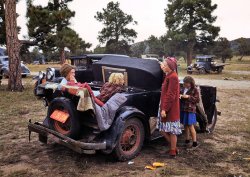
- Pie Town: 1940
- ... October 1940. "General Merchandise store, Main Street, Pie Town, New Mexico." View full size. 4x5 Kodachrome transparency by ... three shops on Main Street and one is a taxidermist.
Pie town Was the reason Pie Town had dugout buildings because of its ... Posted by Dave - 08/01/2012 - 1:32pm -
![Pie Town: 1940 October 1940. "General Merchandise store, Main Street, Pie Town, New Mexico." View full size. 4x5 Kodachrome transparency by Russell Lee.
amusing...Only three shops on Main Street and one is a taxidermist.
Pie townWas the reason Pie Town had dugout buildings because of its location in the hot desert area of NM? Where was Pie town located exactly in NM and does it exist today?
[Can you use Google? Wikipedia? Pie Town is up around 7000 feet elevation. It's not in the "hot desert." Pie Town website. - Dave]
Pie TownYes, I can use Google & Wikipedia, thought it was easier to ask than have to look up. Thanks for the info anyway. Oh and thanks very much in creating a fantastic web site that really tells the story of our country's developement, advancements, hardships and it's people. This web site would be a great asset in history classes for all grades, wish it was around when I went to school.
Pie TownPie Town still exists and looks much the same today.
located in west central N Mex at elevation of 6200 ft.
old cowboy camp in the 1870s that sold pies from homesteader wife. high desert country with mild summers and some snow in winters.
Pie Town DugoutsThe reason for using dugout buildings might be for insulation in the winter. No draft in the corners, see.
Dugout buildings are veryDugout buildings are very common in colder places. Almost all the Central European immigrants who homesteaded the Canadian Prairie Provinces spent their first year or two in dugout buildings.
As said before, they eliminate drafts (and more importantly they insulate against the cold!), but you also need much less wood to build a dugout building. Some had sod roofs and upper walls, and the lower walls were nothing but dirt. It was basically free housing, which was essential because homesteading legally required the owner to live on the land for a certain number of years.
(The Gallery, Kodachromes, Pie Town, Russell Lee, Stores & Markets)](https://www.shorpy.com/files/images/1a34163u.thumbnail.jpg)
- Pie Town Picnic: 1940
- September 1940. "Serving up the barbeque at the Pie Town, New Mexico, Fair." Kodachrome transparency by Russell Lee. View ... New Mexico! Is this a higher elevation or something?
Pie Town elevation Yes, Pie Town is way up at around 8,000 feet. Brrr.
... Posted by Dave - 09/07/2011 - 5:18pm -
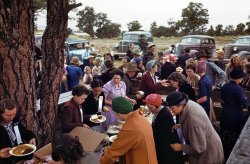
- Pie Town: The Musical
- Pie Town schoolchildren singing. October 1940. View full size. 35mm ... by Paul Hendrickson in the Smithsonian article on Pie Town.
Pie Town: The Musical Those poor kids. Look at how dirty most of them are. ... Posted by Dave - 09/07/2011 - 3:58pm -
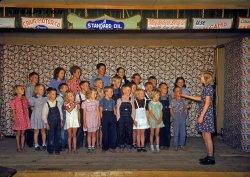
- Pie Town Dugout: 1940
- ... homesteader, coming out of his dugout home at Pie Town , New Mexico." View full size. 4x5 Kodachrome transparency by ... Islands, Alaska. Not quite the dugout captured so well in Pie Town by Mr. Lee, but the principle is the same: the temperature below the ... Posted by Dave - 08/30/2012 - 12:01pm -
![Pie Town Dugout: 1940 October 1940. "Mr. Leatherman, homesteader, coming out of his dugout home at Pie Town, New Mexico." View full size. 4x5 Kodachrome transparency by Russell Lee. Another example of the dugout-style structure used for the homesteader dwellings and church in the Dead Ox Flat photos. Before industry and technology gave us sawmills and frame houses, this is how the average person lived in much of the world. The dugout or pit house, with sod roof, log walls and earthen floor, is among the most ancient of human dwellings -- at some point in history your ancestors lived in one. Especially popular among 19th-century settlers in the Great Plains and deserts of the West and Southwest, where trees and other building materials were scarce, dugouts were warmer in winter and cooler in summer than above-ground structures; just about anywhere in North America the ground temperature three feet down is 55 degrees regardless of the season. [Addendum: This picture was taken using Kodachrome sheet film (5 inches by 4 inches) and (probably) a Graflex Speed Graphic press camera. The image you see here was scanned from the positive transparency itself, not a print.]
Pole & Line in BackLikely a dipole antenna for a small radio in the home. Note what appears to be a runner going towards the ground from the mid-point.
Similar Aleut-style dugoutHere is an 1899 photograph from the Harriman Expedition of a barabara, a semi-underground Aleut dwelling on Unalaska, in the Aleutians Islands, Alaska. Not quite the dugout captured so well in Pie Town by Mr. Lee, but the principle is the same: the temperature below the ground’s surface remains fairly constant. In the fiercely windy Aleutians the advantage of below-ground structures is even more enhanced.
Denny Gill
Chugiak, Alaska
HmmNote--the photo is in color. Not real?
[This is one of our most frequent uninformed comments. When do people think color photography began? The answer is that it goes back to the 19th century. Kodachrome film went on the market in 1935. And of course we've all seen Technicolor movies from the 1930s -- The Wizard of Oz, Gone With the Wind, etc. - Dave]
Color photography goes backColor photography goes back a lot further than October 1940. No reason to believe it's fake.
What is the pole and line in back?It seems to have a line or wire running from the pole into the tree, then on to another tree.
Aha!That must be why the first structure ever built at my alma mater looked just like this!
Speak for you own selvesNot MY ancestors!
I love it!I want mine in my backyard so I can go down there with my neighbor!!!!!! Uh huh. I bet I'd still live in one of these babies if my community would allow it. Holy Sh*t!
ColorizedUhm ... Both The Wizard of Oz and Gone With the Wind were filmed in B&W. It wasn't until later re-releases that they were colorized.
[Sigh. Where do people get these ideas?? GWTW (which won an Oscar for color cinematography) and Wizard of Oz were of course both filmed in color. Wikipedia articles on Technicolor and Gone With the Wind. - Dave]
OzThe Wizard Of Oz started filming in 1938. The book's silver shoes became ruby slippers because the movie was one of the few films made at the time to be filmed in color, and MGM wanted to show off the color process. At the time, most movies were filmed in black-and-white thus those parts of the movie were meant to be reality, and the color part was meant to be a dream.
By the way, all this information can be found on the internet, so look up things before you say something because instead of being an expert instead you sound like an idiot.
History of color photographyThe history of color photography.
The Wizard Of OzThe main reason people think the movie "The Wizard Of Oz" is colorized is because 'faded' copies of that film is usually shown on tv. This movie has been recently restored frame by frame to its original look by Warner Studios and even some extra footage has been added. I have that restored movie on DVD and it is visually outright spectacular. Just take a preview look at this here [Warner Bros.]: http://thewizardofoz.warnerbros.com/
Wizard of OzWrong. Wizard's first few minutes and last few minutes were in B&W but the majority of the film was originally in Technicolor!
Wizard of OzActually, you are all wrong. The Kansas scenes were filmed in Sepiatone, which is actually color film. The Oz scenes were filmed in Technicolor.
Blair Frodelius
http://ozmapolitan.spaces.live.com/
Oz, Part 23573"The Kansas scenes were filmed in Sepiatone, which is actually color film. "
Well, just to carry this off topic argument further... sepiatone is not a color film. It is a coloration applied to black and white images resulting in a brown and white appearance, but not a color film in any normal sense.
Looking ForwardDare I say it? There might come a point when these people appear to be ahead of their time. Imagine how much less energy we would use if we took advantage of some of the ground's natural advantages---of course balanced with modern technology to make it a whole lot more comfortable.
Oz ad nauseamUnless someone can prove otherwise, I am convinced the black and white portion of Wizard of Oz was shot on black and white negative.
The Color portion of Wizard of Oz was shot on THREE black and white negatives.
Black and white and sepia are all colors.
You mean I've been in Kansas all along? I saw all of you there though. Were you thinking? Maybe you weren't really there.
But in short, the intro and epilogue was black and white, and the OZ portion was Technicolor.
And the prints seen in theatres, I assume were all printed on color positive stock, although it is posible if there was a reel change, the intro and epilogue actually COULD have been printed on black and white stock.
The real question is... was the sepia toning of the black and white portion originally there, in the theatre prints? Watching the movie on TV growing up, I would say it was not, unless the networks decided to pump away the sepia technically. When the film was restored for video release since 1980, sepia toning of the black and white portion was probably done. Electronically. You know, to make it look old. I haven't watched the film since its first 'restored' vhs release, except to listen to Dark Side of the Moon.
Sepia toning usually takes place on paper prints (such as via bromination) either as a accidental by-product or intentional archival technique. It generally was not used for movies presented in the theatre, even in cases where it could have been technically possible to fudge the look when printed to color transparency.
And it is cool/hotto live in a hole in the ground. That doesn't make it that feasible for an entire population however. The majority of houses are, and have historically been, ABOVE ground, because it is simply easier to build them that way.
Root cellars were common, to keep stored food at a more constant temperature throughout the year. And beer was often made in caves, as was the mash for whiskey, for similar reasons.
Ad nauseam indeedFrom the Department of Dead Horses:
"The Wizard of Oz" was indeed released theatrically in 1939 with sepia toning to the black-and-white sequences. MGM, for reasons I don't know, used sepia toning rather often in the late '30s. The b/w Oz scenes were shot on b/w stock; the Technicolor sequences were, as described, shot using the Technicolor process, which produced three separate b/w negatives. But the was not originally printed on color "positive" stock; however, but using an imbibition process, which is too complicated to go into here; try this link: http://www.widescreenmuseum.com/oldcolor/technicolor6.htm.
As for toning of films, it was EXTREMELY common during the silent era, as opposed to "generally not used." Try http://en.wikipedia.org/wiki/Film_tinting
Honestly, how do people manage to speak with such authority about things they clearly know nothing about?
I never knew, This is aI never knew, This is a great website.
Oh man...Progress IS fast. I cant believe that people used to live in those...
progress?I agree that we've progressed in the sense of no longer having dirt floors, and tiny houses, but there are certainly advantages to that style of building that we have regretfully left behind. Part of the looming fossil-fuel energy crisis has to do with our dependence on convenient energy, rather than efficiency, in keeping our homes climate controlled. I'd say a similar tradeoff has been made with respect to transportation. Instead of living in close-knit dense communities, we require freeways and cars.
I love seeing stuff like this picture, because it's a reminder that there IS a way to live without energy-rich technological solutions.
[The people of Pie Town, living as they did out in the middle of nowhere, all had cars. - Dave]
FloodingI can't imagine they stayed there very long. What happens when it rains? I don't think there were many sump pumps then.
Photographic HistoryThe first color photographs predate WWI. Even those aside, it's fairly trivial to colorize an existing black and white photo if you feel the urge.
These structures are indeed ancient -- they were common in Japan as early as 400 AD (that's off the top of my head) and elsewhere in the world even earlier.
Interesting to see that they were used in the USA - though it shouldn't shock anyone. The depression wasn't in full force in 1940 but the USA wasn't something a modern resident would recognize. Times were hard.
Great photo.
:(my ancestors were monkeys and couldn't even afford a house like this
I'll give you a "hell yeah"I'll give you a "hell yeah" on that one !!
I thought everyone who grew up watching that movie would realize the significance of the color part of the film.
think we need to put down our game boys and read books again.
Dugout HouseMy mother's family lived in a dugout house near Elida, New Mexico, in the 30's and 40's. They were not poor, and they found the life to be just fine.
Nice dipole antennaI wonder what kind of wireless equipment he has in that shack...
"not my ancestors"where did you come from? obviously not earth...
PlaggenhutIn the Netherlands, these dugout homes or pit houses, 1900 circa, were called "plaggenhut" (sod house or turf hut). They were found typically in the north-eastern part of the country, e.g. in the province of Drenthe.
Vincent Van Gogh visited Drenthe from September till October, 1883. In a second letter, dated around September 15th 1883, to his brother Theo, he wrote:
"I am enclosing a sketch of my first painted study from this neighbourhood, a cottage on the heath. A cottage made entirely of only turfs and sticks."
In Drenthe he painted several studies, the so called third series.
One of them is "Cottages," Oil on canvas on cardboard(?), F17/JH395, 35.5 x 55.5 cm."
(The Gallery, Kodachromes, Pie Town, Russell Lee)](https://www.shorpy.com/files/images/1a34165u_0.thumbnail.jpg)
- Pie Town Sitdown: 1940
- ... The Faro Caudill family eating dinner in their dugout, Pie Town, New Mexico. October 1940. 35mm Kodachrome transparency by Russell ... Barrel.
I am not kidding.
The eventualities of Pie Town You know you're doomed to be a domestic housewife in Pie Town 1940 ... Posted by Dave - 09/07/2011 - 4:09pm -
![Pie Town Sitdown: 1940 The Faro Caudill family eating dinner in their dugout, Pie Town, New Mexico. October 1940. 35mm Kodachrome transparency by Russell Lee. View full size.
Bandaged thumbDad seems to have injured the thumb on his left hand.
You can taste the butter inYou can taste the butter in those biscuits.
Nail polishIt's odd to see the two women wearing nail polish in this photo. They look to be too poor to afford that sort of luxury. But then again, maybe it's food coloring or something.
Nail polishThey had a car, so they could probably afford nail polish. The Pie Towners were all homesteaders. Most of them lived in dugouts with sod roofs. No electricity or running water. Near the end of her life Doris Caudill (the mom) remarked that she'd do it all over again if she had the chance, except she'd like hot and cold running water.
I know this is going to sound stupid......but this pic makes me hungry for Cracker Barrel.
I am not kidding.
The eventualities of Pie TownYou know you're doomed to be a domestic housewife in Pie Town 1940 when your whole right hand just gradually morphs into a big plate of biscuits.
meatdon't see any meat .. vegans
Cracker Barrel Me too! I guess back then this was a fairly "meager" meal but now it's nostalgic and people pay a fair amount for it at Cracker Barrel because so few people are cooking like this at home. Still don't know if i would call it the "good ole days" though.
nail polish is normalNail polish costs about a dollar. Quite possibly, it was the only luxury item they could afford.
YumBeans and biscuits look tasty. Karo syrup? Is that for the biscuits?
In response to the "meat" comment, no they weren't vegans. Fresh meat wasn't readily available, as it is today. It wasn't as simple as going to Kroger and picking up a pack of steaks. According to my father, meat was a matter of the store having any, not neccesarily if you could afford it.
re: YumMy father grew up in the Depression (born in 1920) -- though he seldom speaks about it (he's 86-years old and going strong, thankfully), I can remember him say how his father would give him three or four shotgun shells and telling him that if his hunt was unsuccessful, they would have no meat for supper...
nail polishyou can bet that they had that polish on because of the visiting photographer. Maybe also wore it to church or the fair....one small bottle would last the two of them for a year or two.
Also, no electricity or running water.. think how hard it was to make that meal and clean up afterwards...we are sure spoiled today.
Nail polish was much cheaper than thatBack then it was something like twenty cents. Nowadays even the stuff at the loonie/dollar store costs more than $1, and it's so thin you'd need ten coats to cover.
Pie Town Sitdown 1940I like the Karo syrup bucket that seems to be holding up the platter of biscuits..The syrup and hot biscuits are better than anything that you can find on 98% of household tables today...
"You know you're doomed to"You know you're doomed to be a domestic housewife in Pie Town 1940 when your whole right hand just gradually morphs into a big plate of biscuits." -Anon Tip.
This is the best!!!
*laugh*
American foodKaro syrup is corn syrup- very very sweet. Probably something like Tate & Lyle, it too is golden in color.
I have never heard of a pikelet, but biscuits here are related to scones. They are a quickbread, made with flour, shortening, and baking powder, very flaky. Sort of like pie crust, but heavier. They are not sweet by themselves, but usually served with butter and jam or honey (or Karo syrup, perhaps!)
Karo SyrupIt's high fructose corn syrup, not quite as thick as golden syrup.
TerminologyForgive an englishman's ignorance, but what was Karo syrup - anything like our Tate & Lyle golden syrup (very sweet). Also the biscuits look terribly like what I would call scones or even pikelets - as you know a biscuit over here would be a cookie to you!
Milk JarI was just remembering the other day about how we kept our milk in the fridge in a big glass jar like this one. Dad would milk and bring it in--we'd strain it and put it in the jars. Later we skimmed off the cream that had risen to the top to make butter or just stirred it back in before we poured out what we drank or used on our cereal.
Nail polish, etc.Yep, that family is spruced up for photos. I love the little girl's hair with the ribbon! Moms got a fresh dress and apron. Boy's clothes clean, hair brushed nicely. But perhaps Dad didn't want anything to do with this, or just came in from the fields. Dad got his piece of pie early, kids probably had to wait til finished eatinc.
That's linoleum on the table. The old standby that covered nearly everything in the 30s.
DinnerThis harks back to a simpler time, when "time with the family" was just that.
We've lost so much.
Faro CaudillFaro's life dates, according to the Social Security Death Index: Born June 18, 1908, died June 1976 in Albuquerque.
Shirt pocketIs that a pack of Camels in Dad's shirt pocket? Or maybe a plug of chewing tobacco? I magnified to 300, but can't tell what I see.
[Detail from the full-size scan. -tterrace]
(The Gallery, Pie Town, Rural America, Russell Lee)](https://www.shorpy.com/files/images/1a34105u_1_0.thumbnail.jpg)
- Pie Town Homesteaders: 1940
- September 1940. Jack Whinery, Pie Town, New Mexico, homesteader, with his wife and the youngest of his five ... of the worn-out car which brought this family to Pie Town from West Texas. 4x5 Kodachrome transparency by Russell Lee, Farm Security Administration. View full size.
More on Pie Town From Smithsonian .
Witness Kodachrome has such a richness ... Posted by Dave - 08/30/2012 - 12:02pm -
![Pie Town Homesteaders: 1940 September 1940. Jack Whinery, Pie Town, New Mexico, homesteader, with his wife and the youngest of his five children in their dirt-floor dugout home. Whinery homesteaded with no cash less than a year ago and does not have much equipment; consequently he and his family farm the slow, hard way, by hand. Main window of their dugout was made from the windshield of the worn-out car which brought this family to Pie Town from West Texas. 4x5 Kodachrome transparency by Russell Lee, Farm Security Administration. View full size.
More on Pie TownFrom Smithsonian.
WitnessKodachrome has such a richness and vibrancy, eh? This photo makes it seem like we're standing at the photographer's right shoulder, looking on, feeling the Whinery's discomfort in what must have been a very small space. Sixty-seven years on, and we're right there. Thanks Mr. Lee.
Denny Gill
Chugiak, Alaska
Love the colorEvery time I look at one of these photos from the 40s, with that deep, rich color, I think we must have entered a color "dark age" of sorts in the 60s, 70s and 80s...
Loudon The Second?Something about this guy's face reminds me of Loudon Wainwright III
DignityA sense of dignity is shown by this family. I think today's news media would tell them to "look defeated/miserable" before taking the photo.
Modern media?If a freelance photographer went to take pictures of a family in these circumstances today he wouldn't likely be able to sell the photos, because no newspaper would be interested in publishing them. If he had a good shot of Lindsay Lohan, he could make $400,000 at bare minimum.
So why again would he waste his time taking pictures of these people?
[Russell Lee wasn't freelance. He was employed by the Farm Security Administration. - Dave]
Hellooooooo handsome!I'm getting a time machine and moving to Pie Town.
Going back to Pie TownI Google Mapped Pie Town and zoomed in on the streets. You can also "stand" on the hiway there as well. You can also go to Pietown's own website and see a few photos.
Would like to know where his dugout house was and what happened to it.
My brother said something profound about all these pictures. He's only in his forties, but he said, "I wasn't even alive and I miss this stuff."
I think of these photos as true Americans. I miss it too, and I want it back!
>>--------->
(The Gallery, Kodachromes, Pie Town, Rural America, Russell Lee)](https://www.shorpy.com/files/images/1a34170u.thumbnail.jpg)
- Our Town: Pie Town!
- Main Street, Pie Town. Sept. 1940. Kodachrome by Russell Lee. View full size.
(The Gallery, Pie Town, Rural America, Russell Lee) ... Posted by Dave - 09/07/2011 - 3:53pm -
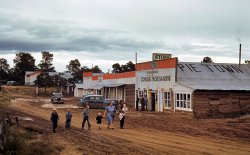
- Pie Town Picnic: 1940
- Sept. 1940. "Serving the barbecue dinner at the Pie Town, New Mexico Fair. Pie Town is a community settled by about 200 migrant Texas and Oklahoma farmers ... Posted by Dave - 09/07/2011 - 4:02pm -
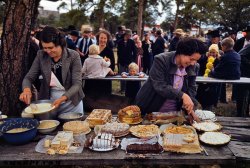
- Pie Town P.O.: 1940
- ... daily brings in mail, freight, express and passengers to Pie Town, New Mexico." Medium format acetate negative by Russell Lee. View full size.
Pie Town Mail Drama Two years ago the USPS said they were closing the town's ... Posted by Dave - 08/06/2020 - 6:24pm -
![Pie Town P.O.: 1940 June 1940. "The stage which daily brings in mail, freight, express and passengers to Pie Town, New Mexico." Medium format acetate negative by Russell Lee. View full size.
Pie Town Mail DramaTwo years ago the USPS said they were closing the town's PO building due to it being unsafe and beyond repair. The residents kicked up enough of a fuss, with some high-powered help, that the plan to relocate services to another town 20-ish miles away were scrapped. Pie Town is still on the (postal) map.
ChicksLooks like someone is getting a bunch of chicks to raise in those boxes on the left. We used to get those in my long-ago boyhood and raise them in the “brooder”. The brooder was a feeder that had a light to keep the little ones warm until they got some feathers. First thing you knew, there were eggs to eat and nice fryers to have for Sunday dinner.
Smoke 'Em If You Got 'EmIt's a gas station. What could go wrong?
Straps GaloreThose are some beautiful suitcases strapped on there next to the baby chicks... I would love to own just one! Someone is traveling in style!
The Red, White & Blue of BarnsdallThe globes, decked out in all their color!
Well Carl,I still think we should have bought the truck.
'38 Chrysler RoyalLooks like a 1938 Chrysler Royal sedan from what we can see of it. A very cool pic for sure. I will buy a print of this one.
[The car is a 1937 Plymouth. - Dave]
The Real McCoy!I see Amos McCoy (Walter Brennan) is in town to pick up his load of chicks for the farm.
The Miracle of the Precariously-Piled PortmanteauxI can think of no other reason besides divine interdiction to explain how this Physics 101 nightmare-on-wheels made the 75+ miles from Springerville (or Socorro) to Pie Town, lurching and bouncing and wheezing over winding trails of washboard and ruts, without that precarious pile of portmanteaux bouncing off and scattering to the winds, somewhere outside of Quemado (or Magdalena).
A close look shows a mere wisp of cord (and substantial prayer to the Gravity God) holding the top valise in place. If my father ever saw this load, once he recovered from the resulting angina attack, he would mutter "No! No! No!" and send me to fetch another 100+ft of rope.
Mr. Lee, however, provides proof that the load survived at least half of its journey, and for that demonstration of divine providence and travelling mercies, can I get an AMEN?!
I will submit an application to the Congregation for the Causes of Saints, making the case that Santa Fe Trailways truly deserves the name "SANTA" Fe Trailways.
[Still, I wonder how many of those chicks arrived scrambled. - Dave]
Prince Albert in a can ...... Clabber Girl in a box.
Royal Family"Well let him out!"
ICC Lights and Reflectors Lots going on in the photo. Interesting to see a automobile fitted with Interstate Commence Commission lighting in addition to being rigged out like a stagecoach. Wonder how long these cars lasted in this type of road service.
Like many chicks I have knownThey come with a lot of baggage.
Both Sides MarkedSANTA FE TR___ Truck Lines? Trucking Co.?
[Trailways. - Dave]
Out in the weatherThey certainly seem to count on rain being infrequent in that part of the country.
(The Gallery, Cars, Trucks, Buses, Gas Stations, Pie Town, Russell Lee)](https://www.shorpy.com/files/images/SHORPY-8b25335a.thumbnail.jpg)
- Top 20 Images of 2007
- ...
No. 1: The Beaver Letter, 1958 (104,800 reads)
No. 2: Pie Town Dugout, 1940 (89,800 reads)
No. 3: Weeki Wachee Mermaid, 1947 ... keeps falling into the champagne fountain! - Dave]
PIE TOWN! PIE TOWN! PIE TOWN! I myself wonder why some of these were so ... Posted by Dave - 01/01/2008 - 8:09pm -
![Top 20 Images of 2007 Welcome to the first annual Shorpy Top 20 New Year's Eve Image Countdown, where we recap the year's most popular posts based on number of reads. You can keep track as the evening progresses on the grid below. (We'll get to the Top 10 starting around 11 p.m. Eastern Time.) And the No. 1 post of 2007, with 104,800 reads: A screen grab of . . . The Beaver Letter! Whew. Well that was fun but exhausting. Thanks to everyone for making this a super first year for Shorpy!
The ranking grid and read numbers reflect picture standings as of 4 p.m. Eastern time on December 31, 2007. View counts rounded to the nearest whatever.
No. 1: The Beaver Letter, 1958 (104,800 reads)
No. 2: Pie Town Dugout, 1940 (89,800 reads)
No. 3: Weeki Wachee Mermaid, 1947 (85,500 reads)
No. 4: Brooklyn Pin Boys, 1910 (84,700 reads)
No. 5: Inter-City Beauties, 1927 (73,200 reads)
No. 6: Pageant of Pulchritude II, 1928 (37,300 reads)
No. 7: Beach Policeman, 1922 (37,100 reads)
No. 8: Mr. 535-07-5248 and Wife, 1939 (36,800 reads)
No. 9: Custer Car, 1924 (24,700 reads)
No. 10: Carina Nebula (20,935 reads)
No. 11: Chicago & North Western Locomotive Shops, 1942 (20,750 reads)
No. 12: 1951 Oldsmobile Final Assembly (18,290 reads)
No. 13: Flying Fortress, 1942 (18,270 reads)
No. 14: Pageant of Pulchritude, 1928 (18,200 reads)
No. 15: The Virtual Buick, 1953 (17,300 reads)
No. 16: Carnival Ride From Hell, 1911 (16,600 reads)
No. 17: Hi-Fi Boombox, 1954 (15,000 reads)
No. 18: Bathing Girl Parade, 1920 (14,900 reads)
No. 19: Migrant Mother, 1936 (14,800 reads)
No. 20: Manhattan skyline in 1901 (14,500 reads)
The Countdown...What a great idea! This is a good way to give the most popular images another viewing, and the grid format with the numbers makes a nice display.
As I write this, we're only at number 19 but the number for views is amazing -- nearly 15,000! It will be interesting to see all twenty, and see if we can generalize about what kind of photographs tend to get the most views here.
Happy New Year, one and all!
[Thanks! I'm so excited my party hat keeps falling into the champagne fountain! - Dave]
PIE TOWN! PIE TOWN! PIE TOWN!I myself wonder why some of these were so popular. Give me a good old Pie Town picture any day. I hope there is a picture from Pie Town in the top 20. Is there Dave? Huh? Is there?
[Mayyybe. Maybe not. Only one way to find out! - Dave]
Top 20Great Idea, I wonder if a "Beaver" shows up or an out of this world photo?
[The envelopes are sealed. No holding them up to the light! - Dave]
Lovin' the countdownNow I'm kinda sorry I'm going out tonight! I'll check back to see how it all turns out as soon as I come home. Happy New Year, Dave, and thanks for all the great Shorpiness!
[Thanks Mattie! Too bad we can't be Tivo'd. - Dave]
Pie Town at No. 2Not bad, not bad at all. There's just something about a place called Pie Town.
[Yep, I was very happy to see that. Although it's a little sad that Shorpy himself couldn't be No. 1 (or even have a spot in the Top 20 ... although if you count his three photos as one, he got close to 20,000 views). - Dave]
The Beaver Letter!Okay, now I can go out for the evening! This was a blast - hope you'll do it again next year!
[Yes, well. Thanks. Hope we're here next year! Which is actually this year. Happy 2008, everyone. - Dave]
Wonderful...Such a fine collection for Shorpy's first annual Top Twenty photos.
Thank you Dave, for all that you do.
Happy New Year everyone, may we all be be blessed with health, happiness, and prosperity in 2008.
(ShorpyBlog, New Year)](https://www.shorpy.com/files/images/girl.thumbnail.jpg)
- Jim and Wife: Pie Town, 1940
- Homesteaders Jim Norris and wife, Pie Town, New Mexico. October 1940. View full size. This is one of hundreds of pictures taken in Pie Town by Farm Security Administration photographer Russell Lee in 1940.
... Posted by Dave - 12/14/2007 - 1:52am -
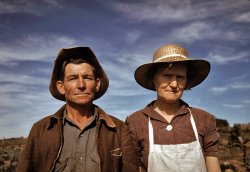
- Pie Town Singers: 1940
- October 1940. Pie Town schoolchildren in a community musical program. 35mm Kodachrome ... Lee. View full size. Another view is here .
Pie Town Children Those well-scrubbed, fresh-faced children are delightful. ... overalls... is Kenneth Mackie. His portrait, taken in Pie Town on Kodachrome in 2006, appears on my "Kodachrome Project" home page: ... Posted by Dave - 09/09/2011 - 11:11am -
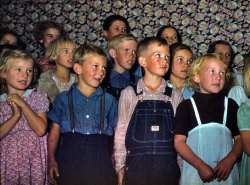
- The House Jack Built: 1940
- Sept. 1940. The Jack Whinery family in their Pie Town dugout. Homesteader Whinery, a licensed preacher, donates his services ... show some kind of dignity or at least of being alive.
PIE TOWN I just talked to some friends who went there this summer. There ... Posted by Dave - 08/30/2012 - 12:02pm -
![The House Jack Built: 1940 Sept. 1940. The Jack Whinery family in their Pie Town dugout. Homesteader Whinery, a licensed preacher, donates his services to the local church. More on the family below. View full size. 4x5 Kodachrome transparency by Russell Lee.
Re: Dancing Africans?Not Africans. Injuns.
There's such a thing as aThere's such a thing as a "licensed preacher"?
Stupid comment hereThe girl second from the right seems to be channeling Napoleon Dynamite. Sorry to ruin it. Juvenile. Sorry.
[Gyaaah! - Dave]
Dancing Africans?I'm a bit intrigued by the pattern on the boy's shirt.
so youngi'm more intrigued with how young they look and how many kiddos they have. wow. looks like the 2 girls on the left are twins.
Sad eyesIn so many pics of poor families in the 30s/40s, I notice how sad (maybe just tired) the mothers look while the dads somehow show some kind of dignity or at least of being alive.
PIE TOWN I just talked to some friends who went there this summer. There are still people who bake pies and have a very rural lifestyle. They said it was a great place!
Licensed preacherSure there's such a thing as a licensed preacher. In many states, there are 2 distinctions: licensed and ordained. A licensed minister is recognized by the state and can perform weddings, funerals and the like. It kind of depends on the church you attend, but ordination is usually church recognition of a minister's credentials.
Sunday best....wonderful how they managed to step up to the plate and present themselves in their "finest'...an amazing and poignant photograph...
me again1940 = year I was born in Norfolk VA..... :-)
Velva MaeIf my research is correct, the Mrs. is Laura Edith, née Evans, and Jack’s full name is Abrim Jack Whinery. The eldest daughter, the camera-shy one on the right, is Velva Mae. If she’s still alive today, she’ll turn 76 on August 29th.
Denny Gill
Chugiak, Alaska
There's a Velva M. Kosakowski who may be the oneHere's her obituary. She's the only Velva in the SSDI born on that date with the middle initial M, and the obit says she's Jack and Edith Whinery's daughter.
It looks like the same Velva Whinery you mention, Denny, but whether she's one of the girls in the photo I don't know. The girl on the right looks far too old to me to be nine (she is almost as tall as her father when sitting plus she has breasts - I'd suggest she was about 12-13), but the girl on the left looks nineish.
Charlene...thank you for the information! I think you're right: the camera-shy girl on the right is likely well beyond nine, now that I look at her again. The obituary you linked us to shows that Velva certainly came a long way from this Pie Town dugout, eh?
Denny Gill
Chugiak, Alaska
The girl on the rightI think that girl is Wanda Whinery. She's mentioned in the obit as being Velva's deceased sister; a Wanda Whinery shows up in the SSDI from the Grand Junction/Clifton, CO area (where they all seem to have ended up). She was born in 1929, so she'd have been 11 in this photo, an age at which most girls are shy, awkward, and uncomfortable.
You're right about it being a long way; a little girl sitting beside her mother to a great-grandmother in her own right.
SadHow old was that mother when she married? She doesn't look that much older than her eldest child. Sad.
namesInteresting how first name fashions come and go. Here we have Jack and Edith (basic early 20th C names) with a Velva and a Wanda, surely exotic names for the time -- though the 30's, when they were born, was a time of experiment in many things... What were the other children called? Bet the boys got more ordinary names.
One boy's name was Lawrence,One boy's name was Lawrence, apparently.
And if the Obit for Velva is right, Wanda Whinery never married - no married name is listed.
They may have been dirt poor, but the kids look healthy and cared for.
young mothers>>>"i'm more intrigued with how young they look and how many kiddos they have. wow."
My paternal grandmother was 15 when she married my grandpa 1932 (in Lovington, New Mexico), and they started a family right away. My grandmother preferred to say that she was "almost 16".
They were actually residing at that time around Brownfield, TX, but they drove all day and night (accompanied by the father of the bride) to the nearest courthouse in NM, because at that time, 16 was the legal age for girls to marry in TX.
Apparently, there was nothing shameful or even unusual for girls to marry at 15 in that place and time, though perhaps 14 might have been pushing it.
Both families were fairly strict and god-fearing people-- poor but not destitute. Grandpa's whole family were members of the Primitive Baptist Church.
Scott, in Taiwan
distichum2@yahoo.com
They are all so thin. NotThey are all so thin. Not starved thin as much as built thin.
Thanks for all the comments on who they might have been!
They are interesting reads.
clothingThe fabric the clothes are made from has to be flour/feed sacks. Perhaps not the father's but the rest of them surely are.
The parents do look so young. Not more then 30. And yet they must have led a hard life up to this point. Amazing the family
resemblance.
Feed Sack FabricIn the late 1800's cotton sacks gradually replaced barrels as food containers. Flour and sugar were among the first foods available in cotton sacks, and women quickly figured out that these bags could be used as fabric for quilts and other needs. Manufacturers also began using cotton sacks for poultry and dairy feeds.
The earliest of these bags were plain unbleached cotton with product brands printed on them. In order for women to use these bags they first had to somehow remove the label, or to make sure that the part of the cloth with the label was not normally visible.
It did take some time for the feed and flour sack manufacturers to realize how popular these sacks had become with women, but finally they saw that this was an opportunity for promoting the use of fabric feedsacks. Their first change was to start selling them in colors, and then in the 1920's began making them with colorful patterns for making dresses, aprons, shirts and children’s clothing. They also began pasting on paper labels that were much easier to remove than the labels printed direstly on the fabric.
By the 1930's competition had developed to produce the most attractive and desireable patterns. This turned out to be a great marketing ploy as women picked out flour, sugar, beans, rice, cornmeal and even the feed for the family farm based on which fabrics and pattern they wanted. I can remember that if my mother was not able to go along when my father went to buy feed, she would often send a scrap of material of the fabric design she needed so that he would be sure to buy the right one. This was during the 1950's.
By the 1950's paper bags cost much less than cotton sacks, so companies began to switch over to this less expensive packaging. The fabric feedsack industry actively promoted the use of feedsacks in advertising campaigns and produced even a television special encouraging the use of feed sacks for sewing, but by the end of the 1960's the patterned feedsack fabrics were no more.
Pink feed sacks...The girls' clothing is actually relatively new cotton muslin, and in quite good shape. Dad and the baby are wearing the most worn-out clothing of all of them.
I doubt feed sacks came dyed with pink flowers or other feminine designs. The ones I own are just plain off-white.
As an aside, I just noticed that all the kids look just like Mom except the oldest daughter, who looks just like Dad.
The Sack DressFeed sacks came in every design imaginable. I have a friend who collects and lectures on them and she has seen literally thousands of different prints. Andover Fabrics out of New York will be doing a line or reproduction fabric based on her collection soon. I've even seen feed sacks printed to look like toile. The variety is astounding.
Information about the Whinery childrenI was in Pie Town a few days ago and managed to find the name of all the Whinery children. The oldest girl is Laura; Velva (middle name "Mae") is in pink, and Wanda is in white. The eldest boy is A.J, and the baby boy's name is Lawrence.
I know for certain that Wanda, Velva, and Lawrence have died. Wanda was born in Adrin, Texas on August 29, 1931 and died on May 27, 2007 at the age of 75. She was married twice, to Clifford Miller on Nov 4, 1956, and she had four children, two boys and two girls, and Chester Kosakowski, age 81, on Oct 31, 2005. In her obituary it says that Wanda and Lawrence preceded her in death, Wanda likely unmarried as they referred to her as Wanda Whinery instead of with a married name. It also said that Laura and A.J. survived her, so unless they have passed away in the meantime, Laura is living in Clifton, Colorado, with the married name Murray, and A.J is living in Dayton (it doesn't say which of the 23 Daytons in the US, so I'm guessing it is Dayton, TX)
I talked to a man who lived in Pie town for all of his life, and he said that he doesn't think the Whinery home is still there. Neither is the Farm Bureau building that the children went to school in. On the other hand, one of the other school buildings is still there and being re-stuccoed and made into a residential home. Their current public schools are in Datil and Quemado, none in Pie Town. The current population of Pie Town is approximately 60 people, and the Pie-O-Neer has better pie than The Daily Pie.
The Farm Bureau buildingThe Farm Bureau building still exists. It is now used as the "Community Center" and is the property of the Pie Town Community Council. A porch has been added along the front, and an additon on the side for a kitchen and restrooms, but otherwise it looks pretty much as it did in the Russle Lee photos from 1940.
Gyaaah! Unbelievable!
(The Gallery, Kodachromes, Pie Town, Rural America, Russell Lee)](https://www.shorpy.com/files/images/1a34169u_1.thumbnail.jpg)
- Walked Eight Miles: 1940
- June 1940. Pie Town, New Mexico. Wife of a homesteader with her WPA (Work Projects ... All with bare feet? That's definitely dedication.
Pie Town It appears that the windows are above ground, no dugout here.
... music, you deserve something better than an accordion.
Pie Town Kids This image (like so many here) is enormously evocative. The ... Posted by Dave - 08/10/2012 - 4:55pm -
![Walked Eight Miles: 1940 June 1940. Pie Town, New Mexico. Wife of a homesteader with her WPA (Work Projects Administration) music class. These children walk eight miles for their music lessons. View full size. Medium-format safety negative by Russell Lee.
OuchAll with bare feet? That's definitely dedication.
Pie TownIt appears that the windows are above ground, no dugout here.
Seems unfairIf you walk eight miles to play music, you deserve something better than an accordion.
Pie Town KidsThis image (like so many here) is enormously evocative. The timer, the foot rest and evidence of recent toil on the clothes and bodies of the boys are among a few after just a few seconds viewing.
Can we relate?
That is why we look here. I have been a loyal Plan59 (EphemeraNow) Shorpy.com visitor/customer for the better part of 10 years. The stunning restoration of some of these scans takes a moment years ago and makes it immediate, right now. I feel like I am the first person to view a newly developed slide the day it was captured.
Important work to be sure.
Foy
All that effort on the partAll that effort on the part of all parties just to bring a little civilization to the wilds of New Mexico.
What is astounding is just how much things have changed in a single generation. The experiences of these people pictured are so removed from our own, I wonder how many of us can even pretend to relate.
But if you had to carry itIf you walk eight miles to play music, you deserve something better than an accordion.
But if you had to carry it for eight miles I wouldn't want anything bigger than an accordion.
[I wonder whose turn it was to carry the piano. - Dave]
Walking 8 milesI can't get my grandsons to walk 8 feet!
Kudos all around While I commend the dedication of these future music greats, remember, it is the home environment and the perseverance of the extended family that ultimately motivated these youngsters to sacrifice for their art. How many of our modern youth would walk several miles for anything? I'm sure there are many, but, overall, we have inherited a way of life that, thankfully, no longer requires that kind of exhausting dedication.
(The Gallery, Kids, Music, Pie Town, Rural America, Russell Lee)](https://www.shorpy.com/files/images/8b25210u_0.thumbnail.jpg)
- Pie Town Rodeo: 1940
- Sept. 1940. Pie Town, New Mexico. "Tying a ribbon on a calf's tail was one of the feature attractions at the Pie Town Fair rodeo." 35mm Kodachrome transparency by Russell Lee for the ... it I love Russell Lee's photos and especially from Pie Town. I'd like to visit this town if I had possibility. I know he had a ... Posted by Dave - 09/13/2011 - 10:11pm -
![Pie Town Rodeo: 1940 Sept. 1940. Pie Town, New Mexico. "Tying a ribbon on a calf's tail was one of the feature attractions at the Pie Town Fair rodeo." 35mm Kodachrome transparency by Russell Lee for the Resettlement Administration. View full size.
Cowboy StyleThe cowboy hats, the boots, the shirts and jeans--all the same--whether this picture was taken yesterday or 70 years ago from yesterday. Very nice and comforting.
Is it chemistry or is it digital magic?Having just gone through a set of color photos I took in 1970, now dim and beige, I am again impressed with how terrific early Kodachrome looks on Shorpy. Is this Dave's digital magic, or was the process actually more stable early on? Or maybe the government took extraordinary care in storing these treasures - though I doubt that.
[Kodachromes are rather famous for color stability. Ektachromes and Anscochromes, on the other hand, are noted for reddish or purplish color shifts over time. Prints, as opposed to transparencies, will also likely change color over time. - Dave]
Dah dum dah dumCue the music from the "Marlboro Man" commercials.
KodachromeThe color here blows my mind. It looks like something taken yesterday. Its sometimes hard to realize history was as colorful as it is today.
Like YesterdayThis photo could have easily been taken yesterday or 70 years ago.
Shorpy, I can't quit you.Every day is another surprise!
An unchange of clothesI think the combination of color and the fact that "cowboy" attire has changed little over the last 80 years makes this photo seem like it was taken recently.
The cowboy on the leftis hot!
Are you on vacation?I've been with you since the very beginning and this is the first time I have to question what you were thinking...I mean really....who cares? The calf?
Just imagineIf that calf is still alive today it would only be a few months over 70 years old.
Calm calfIf I tried to tie a ribbon around my dog's tail there'd be hell to pay. That calf must have resigned itself to the fact that humans are crazy.
Who cares? Well...[xx]-Years-Ago-But-Could-Have-Been-Taken-Today is one of my favorite sub-genres of Shorpy photos, On Vacation individual.
CowboysI like how this guy on the left seems so manly -- I like it really anytime someone from the past lives up to our crazy expectations that we probably got from movies.
I'm lovin' itI love Russell Lee's photos and especially from Pie Town. I'd like to visit this town if I had possibility. I know he had a lot of pictures from that place, please publish them!
[Click the "Pie Town" tag above the photo. - Dave]
(The Gallery, Animals, Pie Town, Russell Lee)](https://www.shorpy.com/files/images/1a34157u.thumbnail.jpg)
- Pie Town Parley: 1940
- October 1940. "Farm family after evening meal. Pie Town, New Mexico." Medium format acetate negative by Russell Lee for the ... comes from a ranching and farming family a little south of Pie Town. I can say with certainty that the aforementioned engagement between ... Posted by Dave - 06/13/2020 - 12:40pm -
![Pie Town Parley: 1940 October 1940. "Farm family after evening meal. Pie Town, New Mexico." Medium format acetate negative by Russell Lee for the Farm Security Administration. View full size.
Night Time is the Best TimeI love the atmosphere that the photographer achieved with the balance between light and dark, and the interactions between the people. Well done!
It doesn't get any betterIt's just a beautiful photograph and a beautiful moment, especially the engagement between the two women.
Where the men are laconicMy mother comes from a ranching and farming family a little south of Pie Town. I can say with certainty that the aforementioned engagement between the women is partly because those two men didn't say more than six sentences each throughout dinner. And the words "Fine", "Yes", and "No" constitute sentences.
Double word scoreEvery single photo of a table lit by a kerosene lamp reminds me of my dad's story of playing Scrabble by kerosene lamp during Hurricane Carla in 1961. It's a story I've heard in various forms for as long as I've been playing Scrabble, and I'm sure the final version will be told in the memoir he says he's writing. Oh, but unlike the residents of Pie Town, they had electricity when there wasn't a hurricane, right? Well, yeah. He also has childhood memories of his grandmother's place in West Texas, before the REA.
And then there's the story of the stray cow.
Have to sayI can't think of a better photograph on this site. Old friends relaxing after a long day. Wow!
Questions remainAre the older couple parents of the young woman or the man? Whose house are they at or do they share a domicile? Is this a nightly affair or is it weekly? An aspiring writer could run far with this image.
That map tho.I wish I could see a detailed version!
Gogh's "Potato eaters"Real life reenactment, if ever was the one.
Keeping John D. Rockefeller in businessThe table lamp looks to be a Rayo round-wick model with an Argand burner. Rayos were made by Bradley & Hubbard and marketed by Standard Oil; there is a story that a free Rayo lamp came with a purchase of 15 gallons or more of Standard kerosene. Rayos have a rep among collectors as fuel hogs, which quite possibly is why Standard Oil got involved with them in the first place. They became much less popular after 1907, when the Aladdin lamp combined an Argand burner with a Welsbach rare-earth mantle to produce a better and more economical light.
Amazing imageI don't often wonder about technical aspects in most photos, but I would love to know the details on how Lee captured and processed this image so perfectly under these conditions.
[A lot of the processing was by Photoshop, a few hours ago. - Dave]
Reminds me of Hopper's "Nighthawks"I'm aware of the power of the image having neutralized any distracting surroundings by darkness so that you can't help but let the faces tell the story. I'm thinking of Malcolm Gladwell's book, Blink, and how universal are the expressions of our faces. This image is captivating me.
"A lot of the processing was by Photoshop"Photoshop truly is amazing. I looked up this photo on the LoC website and saw just how dark and low in detail it appears from the original negative. The astonishing thing is that all the detail actually was recorded; it's just that film and processing weren't up to recovering it. Dave's restoration augments Lee's talent.
Much as I dream of the past, today has its wonders.
[Any "recovering" of detail would have happened in the darkroom when the negative was printed. - Dave]
Agreed: burning, dodging and other tricks were routine in any darkroom. But even the most artful enlarger artisan would be very hard pressed to ever create a finished print to rival what we can do in Photoshop in seconds.
PainterlyRembrandt lighting a couple of centuries later.
(The Gallery, Kitchens etc., Pie Town, Rural America, Russell Lee)](https://www.shorpy.com/files/images/SHORPY-8b38165a.thumbnail.jpg)
- Pie Town Community Sing: 1940
- June 1940. An all-day community sing in Pie Town, New Mexico. View full size. 35mm nitrate negative by Russell Lee ... stand around, without AC, you'd look that way too.
[Pie Town is way up there. Elevation 6,700 feet. - Dave]
(Music, Pie Town, ... Posted by Dave - 01/16/2008 - 6:27pm -
![Pie Town Community Sing: 1940 June 1940. An all-day community sing in Pie Town, New Mexico. View full size. 35mm nitrate negative by Russell Lee for the Farm Security Administration.
All-Day SingEverybody looks pretty bored.
[But later ... delicious pie! - Dave]
All Day Sing?All day? For real? They sang ALL DAY? Zoinks! They really had to work for that pie!!
Singing StyleDo you think they are singing shaped note or "fa so la"?
I think it's also called Sacred Harp singing. Used to be (still is?) very popular in rural churches: All Day Singing and Dinner on the Ground
likely not shape-notelikely not shape-note or they'd be sitting around the room facing each other (hopefully close to a square).
Bored or hot?I'm not sure they're bored. I think they are about to pass out from the heat. See how wide open those doors are? If you've ever been to New Mexico on a summer day, and had to stand around, without AC, you'd look that way too.
[Pie Town is way up there. Elevation 6,700 feet. - Dave]
(Music, Pie Town, Rural America, Russell Lee)](https://www.shorpy.com/files/images/8a28924u.thumbnail.jpg)
- Pie Town Singers: 1940
- ... members of the ladies' quintet at a community sing in Pie Town, New Mexico. View full size. Medium-format safety negative by ... I don't think it gets any better.
(The Gallery, Music, Pie Town, Russell Lee) ... Posted by Dave - 07/24/2012 - 7:03pm -
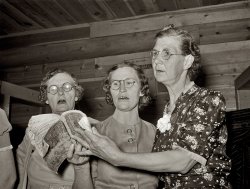
- Pie Town Garden: 1940
- ... Garden and dugout home of Jack Whinery, homesteader at Pie Town, New Mexico. View full size. 4x5 Kodachrome transparency: Russell ... No food in this garden!
(The Gallery, Kodachromes, Pie Town, Rural America, Russell Lee) ... Posted by Dave - 08/30/2012 - 12:01pm -
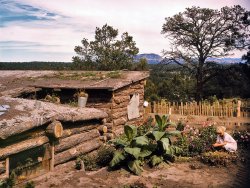
- Pie Town Barbecue: 1940
- ... 1940. Barbecue dinner at the Catron County Fair at Pie Town, New Mexico. View full size. 35mm Kodachrome transparency by ... here . And here . - Dave]
(The Gallery, Pie Town, Rural America, Russell Lee) ... Posted by Dave - 09/08/2011 - 5:29pm -
![Pie Town Barbecue: 1940 September 1940. Barbecue dinner at the Catron County Fair at Pie Town, New Mexico. View full size. 35mm Kodachrome transparency by Russell Lee.
Kodachrome...I still find it stunning to see a photo of this vintage with such incredible color. I don't know when Kodachrome was first introduced but it must have knocked people's socks off! No wonder Paul Simon wrote that song.
[Circa 1935. Kodachrome is a transparency film (positive as opposed to negative - the image has to be projected or backlit for viewing), so was not used much for making photographic prints (snapshots), but was widely used for color separations in publishing. Before slide projectors got popular, the public's main exposure to Kodachrome was color pictures in magazines. One of the first to use it in a big way was National Geographic. - Dave]
BBQAwesome image. Everyone is just going about their business and nobody notices they are being photographed. It's like the photographer was completely invisible.
Kind of odd that there are no tables or chairs or benches anywhere. It looks very ad hoc.
[How can we tell from just one photo that there are "no tables or chairs or benches anywhere"? They're here. And here. - Dave]
(The Gallery, Pie Town, Rural America, Russell Lee)](https://www.shorpy.com/files/images/1a34115u.thumbnail.jpg)
- Pie Town BBQ: 1940
- ... 1940. "Homesteader and his children eating barbeque at the Pie Town, New Mexico Fair." Kodachrome transparency by Russell Lee. View full ... days of the FIRE ANT!
jpf
(The Gallery, Kids, Pie Town, Rural America, Russell Lee) ... Posted by Dave - 09/07/2011 - 5:17pm -
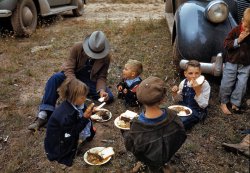
- Pie Town Still Life: 1940
- ... 1940. Crops and vegetables at Catron County Fair at Pie Town, New Mexico. View full size. 4x5 Kodachrome transparency by Russell Lee, one of hundreds of photos he made of Pie Town for the Farm Security Administration.
(The Gallery, Kodachromes, ... Posted by Dave - 08/10/2012 - 4:14pm -
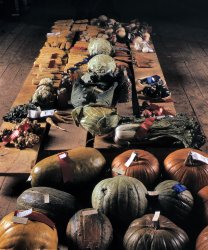
- Pie Town Quilt II
- ... beans. She quilts while she rests during the noon hour. Pie Town, N.M. October 1940. View full size. 35mm Kodachrome transparency ... much more lovely than hanging on a line!
(The Gallery, Pie Town, Rural America, Russell Lee) ... Posted by Dave - 09/07/2011 - 4:08pm -
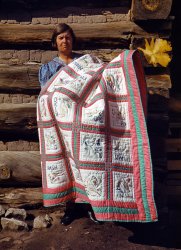
- Pie Town Ice Cream: 1940
- June 1940. "Ice cream party at Pie Town, New Mexico. Ice cream is a great treat for someone who must drive ... for the Farm Security Administration.
(The Gallery, Pie Town, Rural America, Russell Lee) ... Posted by Dave - 12/30/2007 - 8:37pm -
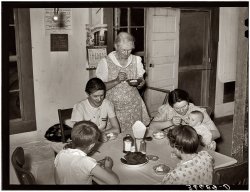
- Country Store: 1940
- ... of the Farm Bureau, in front of the general store. Pie Town, New Mexico." Medium format negative by Russell Lee. View full size. ... fall. Now lawyer up.
Amarrilla by morning up from Pie Town.
I hope somewhere in the world there are places still this simple ... Posted by Dave - 06/15/2020 - 3:26pm -
![Country Store: 1940 June 1940. "Mr. Keele, merchant and president of the Farm Bureau, in front of the general store. Pie Town, New Mexico." Medium format negative by Russell Lee. View full size.
Where the sidewalk endsIn a more litigious time, the boards constituting a walkway outside the store would be an ambulance chaser's dream. Have a nice trip! See you next fall. Now lawyer up.
Amarrilla by morningup from Pie Town.
I hope somewhere in the world there are places still this simple and quaint.
TobaccoThis sure makes me glad I stopped smoking.
Lowering the Boom"Dammit Jenkins, if I've told you once, I've told you a thousand times: keep that boom mic OUT of the frame!"
While this is probably just a furtive finial, it's important to keep Jenkins on his toes!
[Or could it be a light bulb? - Dave]
Going to Fish CreekThere are some misspellings on the sign showing locations in Arizona. McNarry should be McNary, and Miama should be Miami, a copper mining town near Globe. The most interesting is Fish Creek, along Arizona Route 88 (called the Apache Trail) from Apache Junction to the Roosevelt Dam. It's mostly known for the white knuckle drive on a precipitously narrow dirt road down Fish Creek Hill. When I moved to the area 40 years ago, driving down Fish Creek Hill was considered a rite of passage for greenhorns!
Here's a nice picture of the road in the area of Fish Creek:
Daniel Fahrenheit's InventionMercury reads around 78 degrees Fahrenheit. Long pants and long sleeves optional. Hat required.
Open 24 hours?Where is the door??
[The doors are open. - Dave]
Country Store colorizedClick here to watch Jordan J. Lloyd colorize the photograph taken a few moments earlier (?), from start to finish. In the past I did some colorizing of Shorpy pictures myself, e.g. this or this, but having seen this pro at work, I think I better quit, or learn it myself of course, I would like to, I admit.
Pie Town is still a great placeIt's well worth the drive off I-25 in Socorro, past the VLA telescopes, thru Datil (great general store/restaurant), to the Pie-O-Neer cafe, which opens at 11:30 am. Fabulous pie, terrific people! A few old buildings are still standing; don't know if any of them have been shown in this series.
Las Vagas?That's 281 miles to New Mexico's Las Vegas. Nevada's is 500 miles. But neither is spelled "Vagas," and the longer the drive, the more numb one's vagus.
Seventeen ads for tobacco productsBut only two are for “tailor mades.” Folks round those parts chaw plug or leaf, puff a pipe, or roll their own.
(The Gallery, Pie Town, Russell Lee, Small Towns, Stores & Markets)](https://www.shorpy.com/files/images/SHORPY-8b25367a.thumbnail.jpg)
- Santa Fe Trailways: 1940
- June 1940. "Stage in front of the post office at Pie Town, New Mexico. This stage comes through daily except Sunday. It takes in cream for the Pie Town farmers to Magdalena and Socorro and then returns the empty cans." Our ... Posted by Dave - 06/15/2020 - 2:10pm -
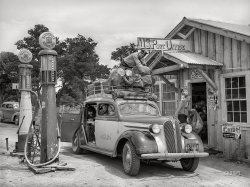
- Pie Filling: 1940
- June 1940. "The gasoline pumps at Pie Town, New Mexico." Medium format acetate negative by Russell Lee for the ...
Pie-O-Neer No Mo Sadly, the famous pie source in Pie Town, the Pie-O-Neer Cafe, closed its doors for good after the coronavirus ... Posted by Dave - 12/08/2021 - 12:33pm -
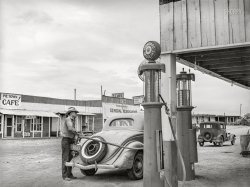
- Grunge Band: 1940
- ... 1940. "Farmer, his wife, and brother in close harmony. Pie Town, New Mexico." Nitty, Gritty and Pretty. Medium format negative by ... can see Woody Guthrie sitting down and singing along.
Pie Town Shorpy has taken us here before. I see there's still no ... Posted by Dave - 07/31/2018 - 11:26am -
![Grunge Band: 1940 June 1940. "Farmer, his wife, and brother in close harmony. Pie Town, New Mexico." Nitty, Gritty and Pretty. Medium format negative by Russell Lee for the Farm Security Administration. View full size.
This land is your land --Woody Guthrie would so enjoy this photo. I wish we could hear it.
Music makingI really love the old photos of people making their own music at home. I kind of wish that was a more common thing in today's world!
This land is your land --I can see Woody Guthrie sitting down and singing along.
Pie TownShorpy has taken us here before. I see there's still no laundromat.
[These people didn't have indoor plumbing or electricity, either. - Dave]
(The Gallery, Music, Pie Town, Russell Lee)](https://www.shorpy.com/files/images/SHORPY-8b25295a.thumbnail.jpg)























